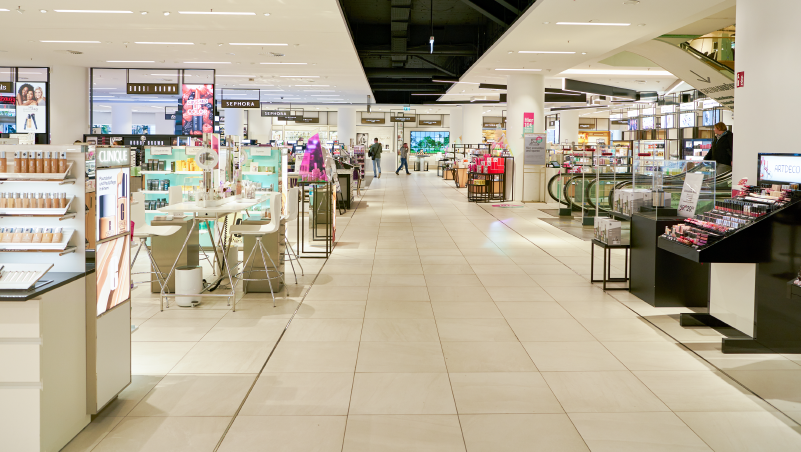This department store, originally from El Salvador, has been operating for over 100 years and has currently been regionalized with 15 branches throughout Central America. It features a wide variety of merchandise including clothing, cosmetics, housewares, electronics, and sporting goods.
THE CHALLENGE
The department store has a customer service area, where different services such as complaints, queries, credits, and card openings, among others, were addressed and attended to. It was served on a first-come, first-served basis, by issuing two tickets: first arrival and first departure, without segmenting by type of service. Customer service representatives did not specialize in any service, they all attended to everything without mastering a specific area.
The problem was known, and the goal was to improve service times, customer experience, and the number of people waiting in waiting rooms. They wanted to count the cases by type of services, to know which services had the highest demand, thus specializing staff in specific areas. Further, measuring staff productivity was a priority, which would be measured by collecting the times each executive took in each service.
There were no waiting times or service controls, so a basic service could last up to an hour, which had a direct impact on long wait times for customers who only wanted to resolve a 5-minute issue, creating one of the biggest challenges they faced when trying to improve the customer experience.
In addition, there was a need for a second area, where customers came to pick up purchases made online. The problem was that there was only one person who carried out the entire process, from the receipt of the customer's order to searching the purchase system by means of the invoice, then searching for the product in the warehouse and delivery of the product.
Most of the time there was an agglomeration of people waiting and disruptions in service since there was no system that managed the queues.
THE SOLUTION
In February 2021, Q-Flow was implemented in two of the store locations, the customer service departments and their associated waiting areas, and the online pick-up service department.
Implemented Solutions in the Customer Service Department:
Q-Flow Queuing System, 100% in the cloud:
Upon arrival, customers check themselves in using the interactive, self-service kiosk, identifying the reason for their visit. Unlike most software that has a physical server, this is all based in the cloud.
![]() Self Service Kiosk:
Self Service Kiosk:
The kiosks are segmented by service type including Customer Service Special Customer Services, and Credits.
![]() SMS Notifications:
SMS Notifications:
Once the service registration at the kiosk is complete, the cus-tomer receives an SMS notification with information about the appointment and wait time, eliminating paper and giving the customer the freedom to return to the department store and to be notified right before their time of service.
 Reports & Insights:
Reports & Insights:
Store and area managers can see reports about sales performance, total services, average service times, SLA comparisons, and the number of services by location.
![]() CRM Integration:
CRM Integration:
Integration with its CRM system eliminates double typing in systems. The advisor only needs to type the service in the CRM and the information is automatically fed into Q-Flow.
![]() Digital Signage:
Digital Signage:
Screens were placed in the waiting rooms displaying information about shifts and other advertisements.
 Account Management & Support:
Account Management & Support:
ACF Technologies supports the company with any issues that may arise and ensures that we have regular meetings to ensure that the system evolves as needed.
Thanks to the success of the pilot, it was implemented in the rest of the stores, adding six branches nationwide, in addition to incorporating the other areas throughout the region Guatemala, El Salvador, Honduras, Nicaragua, and Costa Rica, where the customer can go to pick up the purchased product.
Phase 1:
Queuing by QR code: There was no need for a kiosk, only a QR code was printed which, when scanned by the customer, assigned their turn.SMS notifications: The customer receives their SMS with their shift number and average wait time.
Service Tablets: The service agent has their tablet to make calls and follow up on cases..
 Phase 2:
Phase 2:
Self-Service Kiosk: Customer identification by means of ID.
Integration with SAP allows the identification of the purchase that was made, which saves time for the customer service agent.
SMS Ticket: Integration with your text messaging provider. : The customer receives their SMS with their queueing number and average waiting time, eliminating paper printing.
Service Tablets: Through the integration that was done with SAP, the cases automatically fall with the order number.
In the service console, the purchase information is included so that the service agent recognizes what product to deliver when the customer is called on, looks for it in the warehouse, and delivers it. In the service console, the purchase information is included so that the service agent recognizes what product to deliver when the customer is called on, looks for it in the warehouse, and delivers it.
Digital Signage: Screens were placed in the waiting rooms displaying information about appointments and other advertising.
THE RESULTS
The main result was that, due to the success of the customer service area, the project migrated to the collection area of the products purchased throughout the region.
In the Customer Service area:
- It was possible to identify the services and days with the highest demand, as well as peak hours.
- Reduced wait times.
- Increased productivity.
- It was possible to know the behavior of waiting and service times by branch, by service, and by day.
- By implementing SMS notifications, traffic was redirected from people with a high probability of a new purchase, out of the waiting area and into the store to wait for their service time.
- Increased customer satisfaction.
- Reduced number of dropouts.
The data generated by Q-Flow detailed the wait time and service time for each case or ticket generated, allowing them to know; when, why, and who attended to the customer.
Product Collection Area: - Reduced wait times.
- Proper handling at the time of delivery.
- Reduced crowds of people waiting to collect orders.
- By identifying the customer from the kiosk and integrating with SAP, all online information of the customer order was available.
- Increased productivity. The delivery staff was only responsible for searching for and delivering the products to be purchased in the warehouse.
- Increased customer satisfaction.
- Increased delivery/care capacity.
To learn more about our smart solutions Contact us or Schedule a Demo with one of our experts.
ACF Technologies | Bringing Customers Closer





.jpg?width=300&name=Shutterstock_1926166655%20(1).jpg)